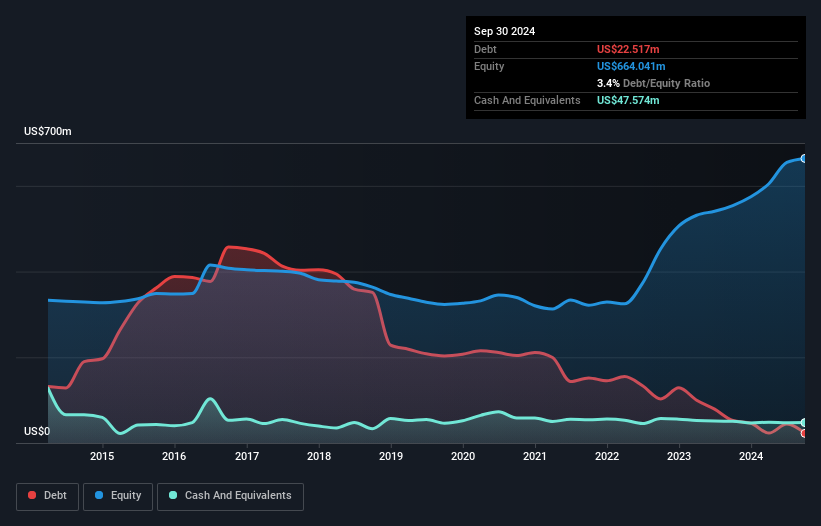The external fund manager backed by Berkshire Hathaway's Charlie Munger, Li Lu, makes no bones about it when he says 'The biggest investment risk is not the volatility of prices, but whether you will suffer a permanent loss of capital.' When we think about how risky a company is, we always like to look at its use of debt, since debt overload can lead to ruin. We can see that Ardmore Shipping Corporation (NYSE:ASC) does use debt in its business. But should shareholders be worried about its use of debt?
Why Does Debt Bring Risk?
Debt and other liabilities become risky for a business when it cannot easily fulfill those obligations, either with free cash flow or by raising capital at an attractive price. If things get really bad, the lenders can take control of the business. However, a more frequent (but still costly) occurrence is where a company must issue shares at bargain-basement prices, permanently diluting shareholders, just to shore up its balance sheet. By replacing dilution, though, debt can be an extremely good tool for businesses that need capital to invest in growth at high rates of return. The first thing to do when considering how much debt a business uses is to look at its cash and debt together.
See our latest analysis for Ardmore Shipping
What Is Ardmore Shipping's Net Debt?
The image below, which you can click on for greater detail, shows that Ardmore Shipping had debt of US$22.5m at the end of September 2024, a reduction from US$52.5m over a year. But it also has US$47.6m in cash to offset that, meaning it has US$25.1m net cash.

A Look At Ardmore Shipping's Liabilities
Zooming in on the latest balance sheet data, we can see that Ardmore Shipping had liabilities of US$37.2m due within 12 months and liabilities of US$21.6m due beyond that. Offsetting this, it had US$47.6m in cash and US$65.1m in receivables that were due within 12 months. So it actually has US$53.9m more liquid assets than total liabilities.
This short term liquidity is a sign that Ardmore Shipping could probably pay off its debt with ease, as its balance sheet is far from stretched. Simply put, the fact that Ardmore Shipping has more cash than debt is arguably a good indication that it can manage its debt safely.
But the other side of the story is that Ardmore Shipping saw its EBIT decline by 6.3% over the last year. That sort of decline, if sustained, will obviously make debt harder to handle. The balance sheet is clearly the area to focus on when you are analysing debt. But it is future earnings, more than anything, that will determine Ardmore Shipping's ability to maintain a healthy balance sheet going forward. So if you're focused on the future you can check out this free report showing analyst profit forecasts.
Finally, while the tax-man may adore accounting profits, lenders only accept cold hard cash. Ardmore Shipping may have net cash on the balance sheet, but it is still interesting to look at how well the business converts its earnings before interest and tax (EBIT) to free cash flow, because that will influence both its need for, and its capacity to manage debt. During the last three years, Ardmore Shipping generated free cash flow amounting to a very robust 83% of its EBIT, more than we'd expect. That puts it in a very strong position to pay down debt.
Summing Up
While we empathize with investors who find debt concerning, you should keep in mind that Ardmore Shipping has net cash of US$25.1m, as well as more liquid assets than liabilities. The cherry on top was that in converted 83% of that EBIT to free cash flow, bringing in US$90m. So is Ardmore Shipping's debt a risk? It doesn't seem so to us. There's no doubt that we learn most about debt from the balance sheet. But ultimately, every company can contain risks that exist outside of the balance sheet. Be aware that Ardmore Shipping is showing 2 warning signs in our investment analysis , and 1 of those is concerning...
When all is said and done, sometimes its easier to focus on companies that don't even need debt. Readers can access a list of growth stocks with zero net debt 100% free, right now.
New: Manage All Your Stock Portfolios in One Place
We've created the ultimate portfolio companion for stock investors, and it's free.
• Connect an unlimited number of Portfolios and see your total in one currency
• Be alerted to new Warning Signs or Risks via email or mobile
• Track the Fair Value of your stocks
Have feedback on this article? Concerned about the content? Get in touch with us directly. Alternatively, email editorial-team (at) simplywallst.com.
This article by Simply Wall St is general in nature. We provide commentary based on historical data and analyst forecasts only using an unbiased methodology and our articles are not intended to be financial advice. It does not constitute a recommendation to buy or sell any stock, and does not take account of your objectives, or your financial situation. We aim to bring you long-term focused analysis driven by fundamental data. Note that our analysis may not factor in the latest price-sensitive company announcements or qualitative material. Simply Wall St has no position in any stocks mentioned.
About NYSE:ASC
Ardmore Shipping
Engages in the seaborne transportation of petroleum products and chemicals worldwide.
Excellent balance sheet average dividend payer.
Similar Companies
Market Insights
Community Narratives



